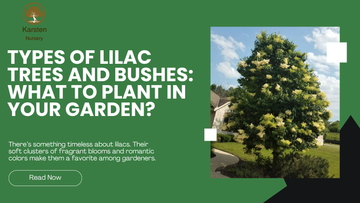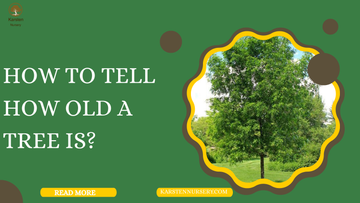Types of Lilac Trees and Bushes: What to Plant in Your Garden?
by Joel Karsten on Oct 10, 2025

There’s something timeless about lilacs. Their soft clusters of fragrant blooms and romantic colors make them a favorite among gardeners. Whether you dream of a large flowering tree or a compact shrub that brightens your yard, there are many types of lilac trees and bushes to explore.
This guide walks you through the most popular lilac species, their colors, heights, and care needs, helping you decide what to plant in your garden this season.
What Are Lilacs?
Lilacs belong to the Syringa genus in the olive family (Oleaceae). There are over 20 lilac species, and countless hybrids that vary in shape, size, and bloom color.
They’re known for being hardy, long-living, and surprisingly low-maintenance. With just a little care, most lilac bush species reward you every spring with clouds of fragrant flowers that attract bees, butterflies, and nostalgia alike.
Lilac Trees vs. Lilac Bushes
People often use the terms “lilac tree” and “lilac bush” interchangeably, but there’s a subtle difference.
-
Lilac bushes are multi-stemmed, dense plants that usually grow between 6 to 15 feet tall. They’re perfect for hedges or small garden spaces.
-
Lilac trees, on the other hand, have a single main trunk and grow taller, with a tree-like shape.
The Japanese Tree Lilac (Syringa reticulata) is the most common example of a true lilac tree variety, while French lilac hybrids and the Korean lilac bush are among the best-known shrub types.
Both are equally stunning; the right choice depends on your garden size and aesthetic.
Popular Types of Lilacs for Every Garden

Let’s take a closer look at the most loved types of lilacs, from traditional purple blooms to compact modern hybrids.
1. Common Lilac (Syringa vulgaris)
The common lilac is what most people picture when they think of lilacs. It grows 8–15 feet tall and produces rich purple to lavender flowers with that unmistakable sweet scent.
There are many lilac plant varieties within this group, including:
-
‘Sensation’ – purple blooms edged with white
-
‘Beauty of Moscow’ – double white flowers with a pink tint
-
‘Charles Joly’ – deep magenta blooms
These are some of the best lilac types for classic gardens or fences.
2. French Lilac Hybrids
French lilac hybrids are celebrated for their full, luxurious flower heads and strong fragrance. Bred from the common lilac, these varieties of lilacs come in many shades of purple, pink, blue, and creamy white.
They’re ideal for formal gardens and bloom a little later than most lilac bush species, giving you extended spring color.
3. Korean Lilac (Syringa meyeri ‘Palibin’)
If you’re short on space, the Korean lilac is one of the best dwarf lilac bushes for small yards. Growing only 4–5 feet tall, it forms a neat, rounded shape that looks great along walkways or patios.
It’s also known for its resistance to mildew, making it one of the easiest, low-maintenance lilac trees for beginners.
4. Japanese Tree Lilac (Syringa reticulata)
This is one of the most elegant lilac tree varieties. The Japanese Tree Lilac grows up to 25–30 feet tall and produces creamy-white blossoms with a light fragrance.
It’s perfect if you want a tree-like lilac standard that provides height and structure to your landscape.
Popular cultivars like Ivory Silk make a beautiful statement when planted along driveways or open lawns.
5. Persian Lilac (Syringa persica)
The Persian lilac stands out among different types of lilac shrubs for its fine-textured leaves and profuse light-purple blooms. It thrives in warmer climates and grows around 6–8 feet tall.
If you love the lilac look but live in a hotter region, this one’s for you.
6. Miss Kim Lilac (Syringa pubescens subsp. patula ‘Miss Kim’)
Miss Kim lilac is another great low-maintenance lilac tree choice. Compact (4–8 feet tall) and highly fragrant, it blooms later than most lilacs, just when you think the season is over.
Its flowers open from dark purple buds to pale lavender petals and gradually turn white, extending the visual interest.
7. Tree That Looks Like a Lilac: Chaste Tree (Vitex agnus-castus)
If you live in a very hot area where true lilacs struggle, try the Chaste Tree, a tree that looks like a lilac. It produces similar purple flower spikes throughout summer and attracts pollinators. Though not a real lilac, it gives the same soft, romantic look.
Read more blog: How to Protect Plants from a Freeze?
Lilac Colors and Shapes
Lilacs come in a lovely range of colors, purple, pink, lavender, and even pure white. The white lilac bush is particularly beautiful for minimalist gardens.
The shape of lilac blooms is usually cone-like, filled with clusters of four-petaled flowers. These colors and shapes make lilacs one of the most recognizable flowering plants in spring gardens.
How Tall Do Lilacs Get?
Wondering how tall do lilacs get?
That depends on the variety:
-
Dwarf lilacs: 3–5 feet tall
-
Common lilac bushes: 8–15 feet
-
Lilac trees: Up to 30 feet tall
If you have limited space, go for compact lilac bush species like the Korean lilac or Miss Kim. Larger yards can easily accommodate taller lilac tree types like the Japanese tree lilac.
Best Lilacs for Fragrance
When it comes to scent, a few lilac varieties are unbeatable:
-
Syringa vulgaris ‘Sensation’ – spicy-sweet and strong
-
Syringa vulgaris ‘Beauty of Moscow’ – soft and romantic
-
Miss Kim – long-lasting fragrance
If you want to fill your garden with perfume, these are the best lilac tree varieties to plant.
Lilac Planting and Care Guide

Lilacs are surprisingly easy to grow. Here’s how to keep them thriving.
When to Plant?
The best time to plant lilac trees is early spring or fall, when temperatures are mild.
Soil and Sun
They prefer well-drained, slightly alkaline soil, and they love full sun, at least 6 hours a day.
Pruning
Regular pruning lilac bushes after blooming keeps them in shape and encourages more flowers next year. Remove any old, woody stems every few years to rejuvenate the plant.
Watering and Feeding
Water deeply but infrequently. A light fertilizer in early spring helps promote healthy growth.
Proper lilac care and maintenance ensure strong growth and vibrant blooms year after year.
Final Thoughts
Whether you prefer the tall beauty of the Japanese tree lilac or the compact charm of the Korean lilac bush, there’s a lilac for every garden. These types of lilac trees and shrubs not only add visual beauty but also fill your outdoor space with fragrance and life.
Want to add lilacs to your garden?
Discover premium, nursery-grown lilac trees and shrubs at Karsten Nursery, your trusted destination for high-quality plants and expert growing advice.
FAQs
1. What do lilac seedlings look like?
Lilac seedlings have small, heart-shaped green leaves and thin stems. They grow slowly at first and begin to form woody branches as they mature.
2. Where do lilacs grow best?
Lilacs grow best in regions with cold winters and mild springs. They prefer full sunlight and slightly alkaline, well-drained soil.
3. What is the size of a lilac?
Depending on the types of lilac plants, sizes range from 3-foot dwarf varieties to 30-foot lilac trees like the Japanese lilac.
4. What color are lilacs?
Most lilacs bloom in purple shades, but there are also white, pink, blue, and even magenta lilac bush colors available.
5. What colours do lilacs come in?
Lilacs come in lavender, violet, white, soft pink, and even yellow-tinted varieties. The color often deepens as the flowers mature.
6. How to identify a lilac bush?
To identify a lilac bush, look for opposite leaf patterns, smooth bark, and cone-shaped flower clusters that bloom in late spring.
7. How many types of lilac trees are there?
There are over 20 species of lilacs and hundreds of hybrids, including kinds of lilac trees like Japanese and Chinese lilacs.
8. Is there a difference between a lilac tree and a lilac bush?
Yes. Lilac trees have a single trunk and grow taller, while lilac bushes are multi-stemmed and more compact.
9. What is the longest-blooming lilac tree?
The Japanese Tree Lilac has one of the longest blooming periods, flowering for several weeks in late spring to early summer.
10. What is the best-smelling lilac tree?
The common lilac and French lilac hybrids are known for their strong, classic fragrance, considered the most aromatic of all lilac varieties.
Read more related blog:




